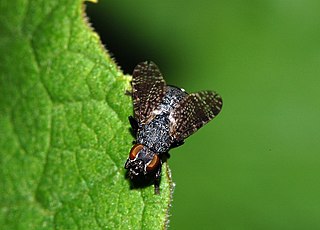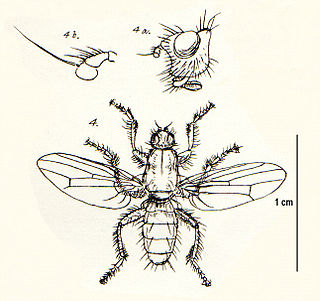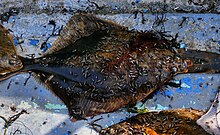
The family Sciomyzidae belongs to the typical flies (Brachycera) of the order Diptera. They are commonly called marsh flies, and in some cases snail-killing flies due to the food of their larvae.

The Anthomyiidae are a large and diverse family of Muscoidea flies. Most look rather like small houseflies. Most species are drab grey to black. Many Pegomya are yellow, and some members of the genera Anthomyia and Eutrichota are patterned in black-and-white or black-and-silvery-grey. Most are difficult to identify, apart from a few groups such as the kelp flies that are conspicuous on beaches.

The Chamaemyiidae are a small family of acalyptrate flies with less than 200 species described worldwide. The larvae of these small flies are active and predatory and are often used for biological control of aphids, scale insects, and similar pests. Chamaemyiid fossils are poorly represented in amber deposits, but a few examples are known from the Eocene epoch onwards.

Canacidae, incorrectly Canaceidae, or beach flies, surf or surge flies, is a family of Diptera. As of 2010, 307 species in 27 genera. The family now includes Tethininae as a subfamily.

The Platystomatidae are a distinctive family of flies (Diptera) in the superfamily Tephritoidea.

Pherbellia is a genus of flies in the family Sciomyzidae, the marsh flies or snail-killing flies. They occur throughout the world, except for the Subantarctic region.

Chaetocoelopa littoralis, commonly known as the hairy kelp fly, is a fly of the family Coelopidae. It is endemic to New Zealand and is widely distributed around the coastline, including offshore islands. These flies are black in appearance and show large variation in size, with males tending to be larger and more robust and 'hairy' than females.

Coelopa is a genus of kelp flies in the family Coelopidae. There are about 14 described species in Coelopa.

Coelopa pilipes is a common European species of kelp fly. It was described by A. H. Haliday in 1838. Their appearance differs greatly from that of other Coelopa flies.
Gluma is a genus of kelp flies in the family Coelopidae.
Dasycoelopa is a genus of kelp flies in the family Coelopidae.

Chaetocoelopa is a genus of kelp flies in the family Coelopidae.
Rhis is a genus of kelp fly in the family Coelopidae.
Amma is a genus of kelp fly in the family Coelopidae.
Beaopterus is a genus of kelp fly in the family Coelopidae.
Glumini is a tribe of kelp flies in the family Coelopidae.
Coelopellini is a tribe of kelp flies in the family Coelopidae.
Coelopini is a tribe of kelp flies in the family Coelopidae.
Coelopinae is a subfamily of kelp flies in the family Coelopidae.
Lopinae is a subfamily of kelp flies in the family Coelopidae.












